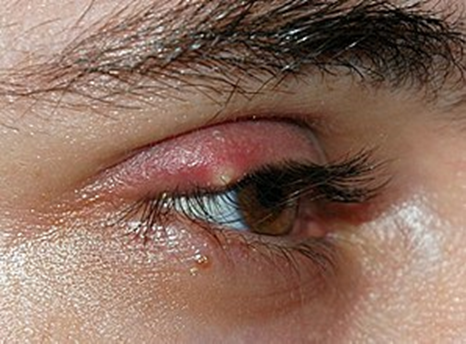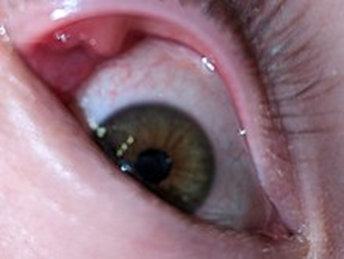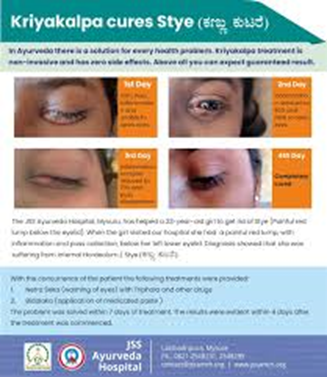Stye
A stye,
also known as a hordeolum, is a bacterial infection of an oil gland in the eyelid. This results in a red tender bump at the edge
of the eyelid. The outside or the inside of the
eyelid can be affected.
The cause of
a stye is usually a bacterial infection by Staphylococcus
aureus.
The internal ones are due to infection of the meibomian gland while
the external ones are due to an infection of the gland of Zeis. A chalazion on the
other hand is a blocked meibomian gland without infection.
A
chalazion is typically in the middle of the eyelid and not painful.
Often a stye
will go away without any specific treatment in a few days or weeks.
Recommendations
to speed improvement include warm compresses.
Occasionally antibiotic eye
ointment may be recommended. While these measures are often recommended,
there is little evidence for use in internal styes.
The
frequency at which styes occur is unclear, though they may occur at any age.
Stye
of the upper eyelid
8-year-old boy with an external horde
olum of lower lid
The first
sign of a stye is a small, yellowish spot at the center of the bump that
develops as pus and
expands in the area.
Other stye
symptoms may include:
·
A lump on the top or bottom eyelid
·
Localized swelling of the eyelid
·
Localized pain
·
Redness
·
Tenderness
·
Crusting of the eyelid margins
·
Burning in the eye
·
Droopiness of the eyelid
·
Scratchy sensation on the eyeball (itching)
·
Mucous discharge in the eye
·
Irritation of the eye
·
Light sensitivity
·
Tearing
·
Discomfort during blinking
·
Sensation of a foreign body in the eye
Complications
Internal style of upper eyelid
Stye
complications occur in rare cases. However, the most frequent complication of
styes is progression to a chalazion that
causes cosmetic deformity, corneal irritation, and often requires surgical
removal. Complications may also arise
from the improper surgical lancing, and mainly consist of disruption of lash
growth, lid deformity or lid fistula. Large styes
may interfere with one's vision.
Eyelid cellulitis is
another potential complication of eye styes, which is a generalized infection
of the eyelid. Progression of a stye to a systemic infection (spreading
throughout the body) is extremely rare, and only a few instances of such spread
have been recorded.
Cause
A stye is
caused by a bacterial infection. The bacteria are Staphylococcus
aureus in
about 95% of cases. The infection leads to the blocking of
an oil gland at the
base of the eyelash. Styes are
experienced by people of all ages. Styes can be triggered by oor nutrition, sleep deprivation, lack of
hygiene, lack of water, and rubbing of the eyes. Styes can be secondary to blepharitis or a
deficiency.
Prevention
Stye
prevention is closely related to proper hygiene. Proper hand washing can
reduce the risks of developing not only styes, but also many other types of
infection.
Upon
awakening, application of a warm washcloth to the eyelids for one to two
minutes may be beneficial in decreasing the occurrence of styes by liquefying
the contents of the oil glands of the
eyelid and thereby preventing blockage.
To prevent
styes, cosmetics and cosmetic eye tools should not be shared among people. Like
with all infections, regular hand washing is essential, and the eyes should not
be rubbed or touched with unclean hands. Contaminated eye makeup
should be
discarded and sharing of washcloths or face towels should be curtailed, to
avoid spreading the infection between individuals.
Breaking
the stye may spread bacteria contained in the pus and should be avoided.
Most cases of
styes resolve on their own within one to two weeks, without professional care. The primary treatment is
application of warm compresses. As a part of self-care at home, people may
cleanse the affected eyelid with tap water or with a mild, nonirritating soap or shampoo (such
as baby shampoo) to help clean crusted discharge. Cleansing must be done gently
and while the eyes are closed to prevent eye injuries.
People with
styes should avoid eye makeup (e.g., eyeliner), lotions, and wearing contact lenses,
since these can aggravate and spread the infection (sometimes to the cornea).
People are advised not to lance the stye
themselves, as serious infection can occur. Pain relievers such as acetaminophen may be
used.
Antibiotics
Evidence to
support the use of antibiotic eye
ointment is poor. Occasionally erythromycin ophthalmic
ointment is recommended. Other antibiotics,
such as chloramphenicol or amoxicillin may
also be used. Chloramphenicol is used successfully in many
parts of the world, but contains a black box warning in the
United States due to concerns about aplastic anemia, which on
rare occasions can be fatal.
Antibiotics
are normally given to people with multiple styes or with styes that do not seem
to heal, and to people who have blepharitis or rosacea.
Procedures
Incision and
drainage are performed if resolution does not begin in the next 48 hours after
warm compresses are started. Medical professionals will sometimes lance a
particularly persistent or irritating stye with a needle to accelerate its
draining.
Surgery is
the last resort in stye treatment. Styes that do not respond to any type of
therapies are usually surgically removed. Stye surgery is performed by an
ophthalmologist, and under local anesthesia. The procedure consists of making a
small incision on the inner or outer surface of the eyelid, depending if the
stye is pointing externally or not. After the incision is made, the pus is
drained out of the gland, and very small sutures are
used to close the lesion. Sometimes the removed stye is sent for a histopathological examination to
investigate possibility of skin cancer.
Alternative
medicine.
A 2017
Cochrane review found low-certainty evidence that acupuncture helps
in hordeolum compared with antibiotics or warm compresses.[23] There
was also low-certainty evidence that acupuncture plus usual treatment may
increase the chance of hordeolum getting better, though they could not rule out
placebo or observer effect, since the studies revied either had no positive
control, were not blinded, or both.
Although
styes are harmless in most cases and complications are exceedingly rare, styes
often recur. They do not cause intraocular damage, meaning they do not affect
the eye. Styes normally heal on their own by rupturing within a few days to a
week causing the relief of symptoms, but if one does not improve or it worsens
within two weeks, a doctor's opinion should be sought. Few people require
surgery as part of stye treatment. With adequate treatment, styes tend to heal
quickly and without complications.
The prognosis
is better if one does not attempt to squeeze or puncture the stye, as infection
may spread to adjacent tissues. Also, patients are recommended to call a doctor
if they encounter problems with vision, the eyelid bump becomes very painful,
the stye bleeds or reoccurs, or the eyelid or eyes becomes red.
Etymology
The
word stye (first recorded in the 17th century) is probably
a back-formation from styany (first
recorded in the 15th century),[25] which
in turn comes from styan plus eye,[26] the
former of which in turn comes from the old English stīġend, meaning
"riser", from the verb stīgan, "to rise". The
older form styan is still used in Ulster Scots today.
The
homonym sty found in the combination pigsty has
a slightly different origin, namely it comes from the Old English (farrow)
is the Old English word for "piglet"—where stiġ meant
"hall" (cf. steward), possibly an early Old Norse
loanword, which could be cognate with the word stīgan above.
The synonymous late Latin expression is hordeolum a modulation of the word hordeolus simply related to hordeum ("barley"), after its resemblance to a barleycorn. In Czech, a sty is called ječné zrno (from ječmen "barley" and zrno "seed or grain"); in German, it is called Gerstenkorn (barleycorn). In Hebrew it is called "שעורה" Seh-oh-Ráh (Barley). In Polish it is called jęczmień (barley).
Jan Ricks
Jennings, MHA, LFACHE
Senior
Consultant
Senior
Management Resources, LLC
JanJenningsBlog.Blogspot.com
412.913.0636
Cell
724..733.0509 Office
April 3 2023






